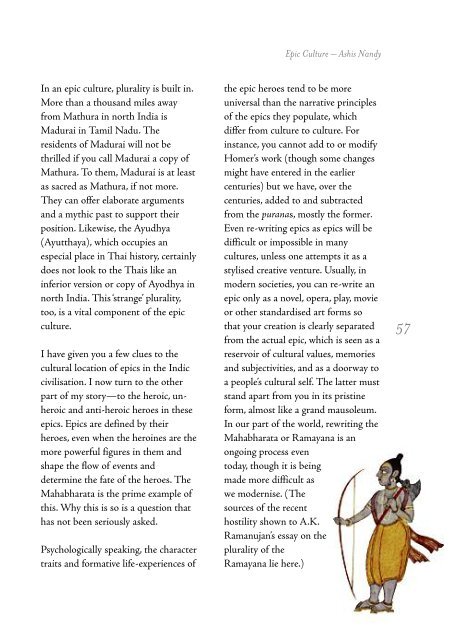Layout 3 - India Foundation for the Arts - IFA
Layout 3 - India Foundation for the Arts - IFA
Layout 3 - India Foundation for the Arts - IFA
Create successful ePaper yourself
Turn your PDF publications into a flip-book with our unique Google optimized e-Paper software.
In an epic culture, plurality is built in.<br />
More than a thousand miles away<br />
from Mathura in north <strong>India</strong> is<br />
Madurai in Tamil Nadu. The<br />
residents of Madurai will not be<br />
thrilled if you call Madurai a copy of<br />
Mathura. To <strong>the</strong>m, Madurai is at least<br />
as sacred as Mathura, if not more.<br />
They can offer elaborate arguments<br />
and a mythic past to support <strong>the</strong>ir<br />
position. Likewise, <strong>the</strong> Ayudhya<br />
(Ayutthaya), which occupies an<br />
especial place in Thai history, certainly<br />
does not look to <strong>the</strong> Thais like an<br />
inferior version or copy of Ayodhya in<br />
north <strong>India</strong>. This ‘strange’ plurality,<br />
too, is a vital component of <strong>the</strong> epic<br />
culture.<br />
I have given you a few clues to <strong>the</strong><br />
cultural location of epics in <strong>the</strong> Indic<br />
civilisation. I now turn to <strong>the</strong> o<strong>the</strong>r<br />
part of my story—to <strong>the</strong> heroic, unheroic<br />
and anti-heroic heroes in <strong>the</strong>se<br />
epics. Epics are defined by <strong>the</strong>ir<br />
heroes, even when <strong>the</strong> heroines are <strong>the</strong><br />
more powerful figures in <strong>the</strong>m and<br />
shape <strong>the</strong> flow of events and<br />
determine <strong>the</strong> fate of <strong>the</strong> heroes. The<br />
Mahabharata is <strong>the</strong> prime example of<br />
this. Why this is so is a question that<br />
has not been seriously asked.<br />
Psychologically speaking, <strong>the</strong> character<br />
traits and <strong>for</strong>mative life-experiences of<br />
Epic Culture – Ashis Nandy<br />
<strong>the</strong> epic heroes tend to be more<br />
universal than <strong>the</strong> narrative principles<br />
of <strong>the</strong> epics <strong>the</strong>y populate, which<br />
differ from culture to culture. For<br />
instance, you cannot add to or modify<br />
Homer’s work (though some changes<br />
might have entered in <strong>the</strong> earlier<br />
centuries) but we have, over <strong>the</strong><br />
centuries, added to and subtracted<br />
from <strong>the</strong> puranas, mostly <strong>the</strong> <strong>for</strong>mer.<br />
Even re-writing epics as epics will be<br />
difficult or impossible in many<br />
cultures, unless one attempts it as a<br />
stylised creative venture. Usually, in<br />
modern societies, you can re-write an<br />
epic only as a novel, opera, play, movie<br />
or o<strong>the</strong>r standardised art <strong>for</strong>ms so<br />
that your creation is clearly separated<br />
from <strong>the</strong> actual epic, which is seen as a<br />
reservoir of cultural values, memories<br />
and subjectivities, and as a doorway to<br />
a people’s cultural self. The latter must<br />
stand apart from you in its pristine<br />
<strong>for</strong>m, almost like a grand mausoleum.<br />
In our part of <strong>the</strong> world, rewriting <strong>the</strong><br />
Mahabharata or Ramayana is an<br />
ongoing process even<br />
today, though it is being<br />
made more difficult as<br />
we modernise. (The<br />
sources of <strong>the</strong> recent<br />
hostility shown to A.K.<br />
Ramanujan’s essay on <strong>the</strong><br />
plurality of <strong>the</strong><br />
Ramayana lie here.)<br />
57


